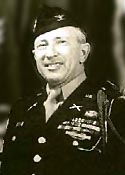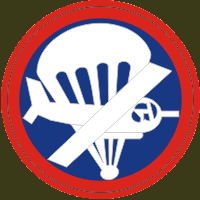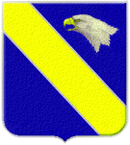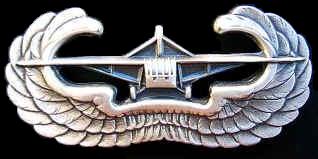|
|
. 401st GIR . GLIDER Infantry Regiment |
|
![]() Roster
Roster
The 401st was formed on March 12th, 1918 but did not take part in the 1st World War.
On June 24th, 1921, the regiment was assigned to the 101st as a reserve unit.
Then, the 101st was affected as an airborne division, on August 15th, 1942 was an infantry regiment and on the 16th as an airborne regiment. Its instruction was done at Camp Clairborne, it was made of two battalions which were supposed to land on with gliders in an area held by parachutists.
The 401st trained in the south and the south-west of The United States and also at Fort Bragg until July 1943.
At that time, it was sent to New York. On September 4th under the orders of Lieutenant Colonel Ray C. Allen it embarked aboard the HMS Strathnaver and got off England in Liverpool.
 <-Lieutenant
Colonel Ray C. Allen
<-Lieutenant
Colonel Ray C. Allen
For the first time, the men were involved in the war. Their quartering was based in a small city at only 60 km from London, in Reading in Berkshire area. Their quartering was located in Brock’s barracks, in the royal regiment of Berkshire.
As they trained in England, the 401st took part in three large military trainings: BEAVER, TIGER and EAGLE.
In March 1944, the 401st had to separate from the 1st battalion which was attached to the 327th as the 3rd battalion. It also lost its 2nd battalion sent to the 325th GIR of the 82rd Division.
It did not remain any more with the 401st that its first battalion which would be frequently used with the 327th.
The 1st battalion of the 401st landed in Normandy on Utah beaches with the 4th Infantry Division in Uncle Red area. It was supposed to join the parachutists.
On June 7th, 1944, it took part in several enlistments, especially with the 506th in order to get St Côme du Mont. It suffered its first losses.
Right before midnight, approaching Angoville au Plain, they were in contact with the 506th.
Colonel Allen, which was a former officer from the Texas national guard was impatient. He contacted immediately Colonel Sink to get his orders for the attack of the following day.
This latter was already sleeping, it was more than midnight.
Immediately after, he joined his commanders of companies together.
In the morning of June 8th, the 401st moved along the Douve. C company of the 1st battalion, commanded by Captain Robert Galbraith carried out the attack followed by the rest of the battalion. It also helped to catch St-Côme-du-Mont in the evening and to catch Carentan on the 15th after 5 days of combats.
Later on, he joined the VII Corps on Utah beach then the V Corps on Omaha beach to join in the 175th Regiment of the 4th Division of infantry at Auville-sur-le-Vey.
After 33 days of combat as the left side of the VII Corps, the 401st was sent to England, on July 13th to remake its strenght. They accepted reinforcements, new equipment and uniforms. It took again its training with the gliders.
In August 1944, Eisenhower established the first allied airborne army made up with the American, the English and the Polish forces.
This new army was used for the first time in Holland, in September 1944.

Holland – September 1944 – operation Market-Garden
The 401st landed off aboard 750 gliders in Holland on September 18th, 1944. It was sent on positions in order to hold open the road midways Eindhoven and St Oedenrode in order to allow the British armoured units to move towards Arnhem. It underwent heavy losses while fighting in Opheusden from October 6th to October 14th, 1944, it fought in this area until it was taken over.
They fought 72 days keeping the road open between Son and Veghel. Combats were extremely hard.
Then, the 401st was sent in rest with the 101st to Mourmelon, France at the end of November 1944.
On the morning of December 16th, 1944, the Germans launched a great offensive crossing the Ardennes woods meeting the American defenses ensured by the VII Corps.
The goal was to catch Antwerp, the only close port which could provide the Allied troops.
At that time, the 101st as well as the 82nd was in rest in France and keot as reserve forces.
The 101st was quickly sent towards Bastogne, a strategic city for the Germans because located at the crossroad of several important roads for their offensive.
The 101st was on the road the night of December 18th on board of trucks.
The 101st Forces were an obstacle to the offensive of Hasso von Manteuffel’s 5th Panzer.
The 401st was insuring the defense of the Southern area with the 327th GIR.
It is in this area the Germans sent emissaries to ask for the surrender of the city, on December 23rd.
His answer back was “Nuts”. Colonel Harper who had the responsibility to give the answer to the Germans had to explain it. The answer was negative - go to hell!
On January 18, 1945, the 401st was back to Mourmelon. On March 1st, 1945, the unit was dissolved, the last battalion of the 401st GIR was reconstituted as the 3rd battalion of the 327th GIR on April 6th, 1945. This Re-designation was actually just a normal renaming because the battalion fought through all over Europe with the 327th GIR.
 The End – 1945
The End – 1945
In March 1945, the 101st was sent to the Ruhr area in Germany. The new 3rd battalion lived its first combats within the 327th GIR in the Rhine and the Ruhr area. On May 8th, 1945, it was closed to Berchtesgaden, at Hitler’s "Eagle Nest”.
The 1st August 1945, the 101st was sent to France in Auxerre ready to prepare to invade Japan but its fall two weeks later cancelled the mission.
The 401st lived large changes in its organization. The men fought savagely to release the peoples from Europe and from the German oppression. Many men of this unit accepted the honors from the battle fields, to remind that this regiment had just a single battalion.
The 401st GIR motto was “All for our Country”.
Men of 401st proved they were an important part of the 101st
during all the Second World War.
United States :
2 Presidential Distinguished Unit Citations for operations in Normandie and Bastogne
France :
War Cross with palms for the Normandy operation
Belgium :
2 War Cross and Lanyards for the Bastogne operations
Holland :
Lanyard Oranje from the Netherlands for the operation Market Garden
![]()

